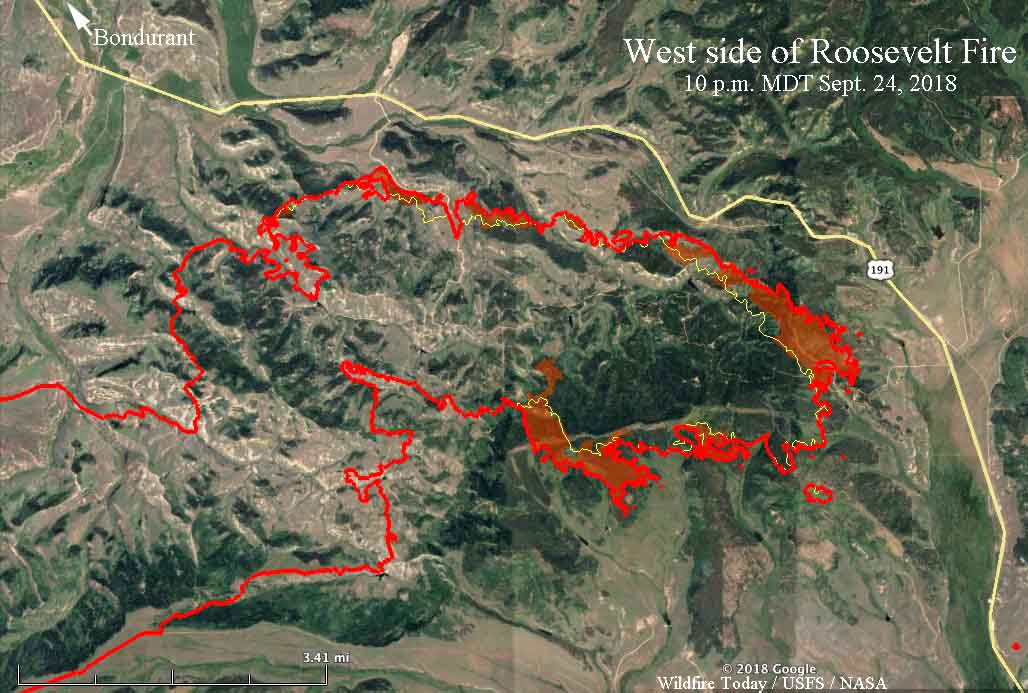(UPDATED at 8:29 a.m. MDT September 25, 2018)
With the Roosevelt Fire approaching to within a quarter-mile of Highway 189/191 firefighters are again planning to conduct a burning operation on the southwest side of the road on Tuesday. They had hoped to start it Monday, but decided to postpone it.
The fire started September 15 and is 6 miles south of Bondurant, Wyoming.
Weather conditions Tuesday should be much more favorable than on Monday. After below freezing temperatures overnight, the forecast calls for 59 degrees, relative humidity in the teens, and west winds of 5 to 9 mph.

The fire grew by approximately 1,500 acres Monday to bring the total up to 49,805 acres. This was a smaller increase than in recent days, with most of the growth occurring on the east side where the perimeter roughly parallels Highway 189/191.
(Originally published at 6:27 p.m. MDT September 24, 2018)
Firefighters on the Roosevelt Fire 30 miles south of Jackson, Wyoming are attempting to fight fire with fire. Their goal Monday through Wednesday of this week is to use a backfire on the southwest side of Highway 189/191 to burn off the vegetation ahead of the fire, hoping it will serve as a barrier as the main fire spreads into the already burned vegetation.
On Monday it was a very difficult task, with 10 to 12 mph winds out of the west and northwest gusting at 20 to 26 mph. These conditions could increase the chance of spot fires across the highway from burning embers lofted by the strong winds.

A Red Flag Warning is in effect for the area until 8 p.m. Monday. For Tuesday through Thursday the wind will decrease significantly. The temperatures will range from the teens at night to the 60’s during the day with little chance of precipitation. Those conditions should give firefighters a chance to make progress against the fire.
The fire is five miles south of Bondurant.
A mapping flight Sunday night at 9:20 determined that the fire had burned 48,348 acres.

Would like to see map of of south side of Roosevelt Fire Thanks.
The rest of the fire changed very little from yesterday’s map.
Sorry, Bill. I would like to see map of south side of fire not the west side. The one nearing Lookout Mtn. Thank you.
The rest of the fire changed very little from yesterday’s map.
Would love to see map of the west side of Roosevelt fire. How close to Lookout Mtn did it get yesterday? Is this possible?
Have we change the definition for backfire? I note, news reports are emphasizing “Backfire” in the headlines versus “Burning out”.
In the old days “burning out” was a tactic used with indirect attack and meant setting controlled fire inside a control line to widen it or consume fuel between the edge of the fire and the control line.
Backfiring was mostly used in an emergency. To set a backfire you waited until the main fire created an indraft and then you set a line of fire to consume the fuel in the path of the main body of fire to and/or change the direction of force of the fire’s convection column.
If you wanted to get the IC or dispatch excited, broadcast “backfire” and you had everyone’s attention.
Jim, I get your point. The term “backfire” is not used often by firefighters. One might say it is under-used. In my mind a backfire is ignited in the path of the main fire. Period. No other conditions. It goes without saying that since it is in the path, it is likely to be a backing fire, but that can vary depending on the distance and timing. I think it is not incorrect to use the term burnout for an operation in the path of the main fire, but backfire is more descriptive, and narrows down the location.
Any burning operation conducted in the path of a spreading fire is a very aggressive choice, and depending on the exact conditions including the distance from the main fire, may come with some risks, both having spot fires across the line, and the safety of firefighters in front of the fire who are igniting more fire with the wind in their face. For example, the Sadler Fire. For those reasons firefighters may sometimes be hesitant to call their burnout operation a backfire.
But those are my thoughts. Here is how the NWCG Glossary defines the terms. There are two definitions, backfire and backfiring. One says it is used with a “rapidly spreading fire”, the other does not. From your choice of words, it appears that you have seen these definitions.
======
Backfire
A fire set along the inner edge of a fireline to consume the fuel in the path of a wildfire or change the direction of force of the fire’s convection column.
see also: Burn Out
Backfiring
A tactic associated with indirect attack, intentionally setting fire to fuels inside the control line to slow, knock down, or contain a rapidly spreading fire. Backfiring provides a wide defense perimeter and may be further employed to change the force of the convection column. Backfiring makes possible a strategy of locating control lines at places where the fire can be fought on the firefighter’s terms. Except for rare circumstance meeting specified criteria, backfiring is executed on a command decision made through line channels of authority.
Burn Out
Setting fire inside a control line to consume fuel between the edge of the fire and the control line.
see also: Backfire
I was taught that the difference between Burning out and Backfiring is tactical Vs. Strategic; burning out is part of direct line construction(cleaning up small islands and eyebrows of fuel between the control line and the main fire) and is a company level decision, while backfiring is employed in indirect situations and is a decision that is made by an IC and supervised by a DIVS.